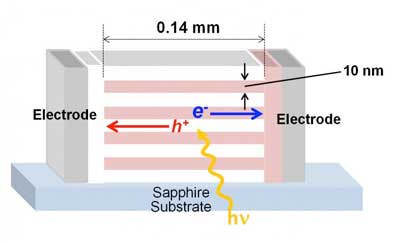| Feb 19, 2019 | |
Beyond the bulkheterojunction(Nanowerk News) Conversion efficiency of organic solar cells have been increased steadily after the invention of bulkheterojunction (blended junction) by research group in 1991. Nowadays, the bulkheterojunction is indispensable for organic solar cells. |
|
| However, a key factor to obtain the high efficiency, namely, the fabrication of electron and hole transport routes in blended cells remains quite challenging. | |
| A vertical alternating multilayered structure having designed vertical routes is an ideal structure, which is equivalent to the structure shown in Figure rotated 90º. However, since the required aspect ratio reaches 100, the designated fabrication of such structures when using current lithography techniques is still very difficult. | |
 |
|
| A lateral organic alternating multilayered junction can be an alternative bulkheterojunction for organic solar cells. (Image: NINS/IMS) | |
| A research group at Institute for Molecular Science had an idea that if carrier transport over a long distance parallel to the substrate is possible, the formation of a vertical route is unnecessary. | |
| The group proposed a novel concept of the structure of organic solar cell, namely, a lateral alternating multilayered junction (Figure). An essential point is that the photogenerated holes and electrons are laterally transported and extracted to the respective electrodes (ACS Applied Energy Materials, "Lateral Alternating Donor/Acceptor Multilayered Junction for Organic Solar Cells"). | |
| Minimum units of proposed junction are hole highway and electron highway. At first, research group demonstrated that lateral extraction of photogenerated holes and electrons of the order of 1 mm in the hole and electron highways using ultra-high mobility organic films. Observed macroscopic value of millimeter order is surprising long compared to the conventional value below 1 µm. | |
| Next, the researchers demonstrated the successful operation of organic solar cell having a lateral alternating multilayered junction by combining the hole highway and electron highway. | |
| A total of 93% of the photogenerated electrons and holes are laterally collected over a surprising long distance (0.14 mm). The exciton-collection efficiency reaches 75% in a lateral alternating multilayered junction with a layer thickness of 10 nm. Therefore, the lateral junction is proved to have an ability to collect both excitons and carriers almost completely. | |
| A lateral alternating multilayered junction can be regarded to be an alternative bulkheterojunction for organic solar cells. Advantage of a lateral cell is its unlimited thickness in the vertical direction. Therefore, tandem solar cells that can utilize the full solar spectrum can be freely designed. The present new concept paves the way to exceed the conversion efficiency of organic solar cells above 20%. |
| Source: National Institutes of Natural Sciences | |
|
Subscribe to a free copy of one of our daily Nanowerk Newsletter Email Digests with a compilation of all of the day's news. |
